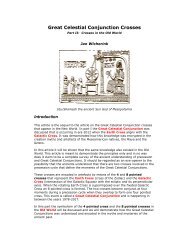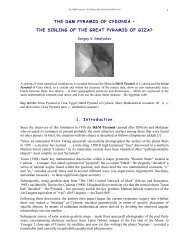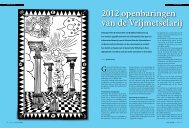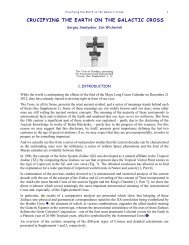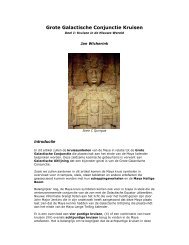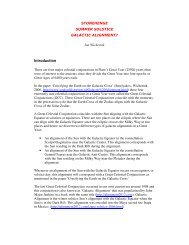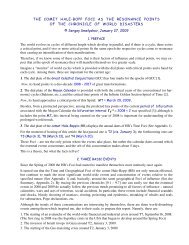Appendix MARS AND D&M PYRAMID ... - Souls of Distortion
Appendix MARS AND D&M PYRAMID ... - Souls of Distortion
Appendix MARS AND D&M PYRAMID ... - Souls of Distortion
Create successful ePaper yourself
Turn your PDF publications into a flip-book with our unique Google optimized e-Paper software.
<strong>Appendix</strong> to “The D&M Pyramid – the Sibling <strong>of</strong> the Great Pyramid <strong>of</strong> Giza?” 1<br />
<strong>Appendix</strong><br />
<strong>MARS</strong> <strong>AND</strong> D&M <strong>PYRAMID</strong> PARAMETERS<br />
The known values and relations for Mars and D&M pyramid are taken from the specified sources.<br />
The author’s notes and considerations are given in the rubric under the heading “Comment”.<br />
Some non-conventional denotations are changed for the purpose <strong>of</strong> clarity and uniformity <strong>of</strong> designations.<br />
A1. The Solar Cycle Constant<br />
The average duration <strong>of</strong> the 11-year Solar activity cycle [14] makes<br />
T 0 = 11.07 years with a relative error <strong>of</strong> about δ * = 1% .<br />
The great importance <strong>of</strong> this value results from that influence these cycles exert onto planetary processes;<br />
they so to say modulate the processes so that the planetary periods follow a Golden section structure <strong>of</strong><br />
periods (ATS – Auric Time Scale) being centred by T 0 , as well as the basic periods in nature and society<br />
on this planet – at least in the interval <strong>of</strong> seconds to hundreds <strong>of</strong> millennia [15]; besides, the actual Solar<br />
cycle periods themselves follow the ATS as well [16]. For this reason this Solar Cycle Constant may be<br />
called a Solar year.<br />
A2. Martian units <strong>of</strong> time<br />
A2.1. Average length <strong>of</strong> Martian sidereal day 24h 37m 22.663s (in Earth time units) [17]<br />
Average length <strong>of</strong> Martian solar day (sol)<br />
A2.2. Sidereal period (year) [6]<br />
Average tropical year [17]<br />
T S = 24h 39m 35.224s (in Earth time units) [17]<br />
1.8809 Julian years (686.98 Earth solar days)<br />
N S = 668.5991 sols<br />
668.5921 sols<br />
Comment A1. Due to a small difference in Sidereal and tropical years, for the purpose <strong>of</strong> this study we<br />
consider an average <strong>of</strong> these two as a Mars year (myr, for short).<br />
T S × N ) / 365.24 = 1.8809 – the Sidereal period <strong>of</strong> Mars in Earth years<br />
24h<br />
( S<br />
A2.3. Precession cycle [17]<br />
T P = 175 000 (yr)<br />
A2.4. Obliquity cycle [18]<br />
T Ob = 124 000 (yr)<br />
During this period the obliquity varies from 15° to 35° (in millions <strong>of</strong> years the swing may be 0° to 60°)<br />
A2.5. Perihelion cycle [18]<br />
T = 43 000 (yr)<br />
Ph<br />
Table A1. The basic Martian cycles in units <strong>of</strong> Martian and Solar years<br />
No. Unit In Martian years (myr)<br />
(1.8809 Julian years)<br />
In Solar years (syr)<br />
(11.07 Julian years)<br />
1 No. <strong>of</strong> days in a year (sols) 668.6 0.16991<br />
2 Precession cycle 93 000 15 800<br />
3 Obliquity cycle 66 000 11 200<br />
4 Perihelion cycle 22 900 3 900
<strong>Appendix</strong> to “The D&M Pyramid – the Sibling <strong>of</strong> the Great Pyramid <strong>of</strong> Giza?” 2<br />
A3. Mars radii and intrinsic units <strong>of</strong> measure<br />
The basic linear measures <strong>of</strong> Mars are as follows [6]<br />
Equatorial radius<br />
Polar radius<br />
R E = 3402.5 km;<br />
R = 3377.4 km.<br />
P<br />
Comment A2. Find the intrinsic units <strong>of</strong> linear measure for Mars by analogy with the geographical mile.<br />
A3.1. The lengths <strong>of</strong> 1° and 1’ <strong>of</strong> Equator<br />
2πRE<br />
Λ E = = 59.38483 (km /degree);<br />
360°<br />
ΛE λ E = 10 3<br />
60 × = 989.7471 (m/arc min).<br />
A3.2. Find the length <strong>of</strong> 1° <strong>of</strong> the latitudinal circle for the latitude <strong>of</strong> the D&M.<br />
Consider a cross-section <strong>of</strong> Mars as ellipse with semi-axes a = R and b = R (Fig. A1).<br />
R P<br />
ψr<br />
R ψ<br />
E<br />
P<br />
ψ<br />
R E<br />
Fig. A1. Radius r ψ <strong>of</strong> the latitudinal circle for the D&M pyramid<br />
2<br />
2<br />
2<br />
2<br />
The radius-vector R ψ for D&M makes Rψ<br />
= ( RE<br />
cosψ<br />
) + ( RP<br />
sinψ<br />
) = 3391 .871 , where ψ = 40.65°<br />
is its latitude (See A4). Then, the radius r ψ <strong>of</strong> its latitudinal circle is equal to r ψ = R ψ cos ( ψ )<br />
= 3391.871× cos 40. 65 = 2573.423 (km) and the lengths <strong>of</strong> 1° and 1’ <strong>of</strong> D&M latitudinal circle make<br />
2πr<br />
ψ<br />
Λ D = = 44.9147 (km /degree);<br />
360°<br />
Λ<br />
λ D =<br />
D 10 3<br />
60 × = 748.578 (m/arc min).<br />
A3.3. Find the average length <strong>of</strong> 1° <strong>of</strong> meridian.<br />
The following approximation gives the length <strong>of</strong> ellipse with half-axes a and b<br />
64 − 3λ<br />
a − b<br />
L ≈ π(<br />
a + b ) , λ = .<br />
2<br />
64 − 16λ<br />
a + b<br />
64 − 3λ<br />
Hence, for Mars we obtain λ = 0. 003702 , L ≈ π( 3402.5 + 3377.4 ) = 21 299. 757 (km), and<br />
2<br />
64 − 16λ<br />
the average length <strong>of</strong> 1° and 1’ <strong>of</strong> Meridian make<br />
ΛM<br />
L<br />
= 360°<br />
Λ<br />
M<br />
λM = × 10<br />
60<br />
4<br />
= 59.16599 (km/degree);<br />
3<br />
= 986 (m/arc min).<br />
4
<strong>Appendix</strong> to “The D&M Pyramid – the Sibling <strong>of</strong> the Great Pyramid <strong>of</strong> Giza?” 3<br />
A4. D&M Pyramid Geographical Coordinates<br />
Viking orbiter frames show that the D&M Pyramid is located at 40.65N 9.55W. All three frames were<br />
taken close to periapsis and yield a pixel resolution <strong>of</strong> ~50 m [3]. The later images from MGS MOC and<br />
from the Mars Odyssey camera give the same (in round figures) location: “near 40.7° N, 9.6° W” [19].<br />
So, we can accept the following geographical coordinates for the D&M pyramid<br />
ψ D = 40.65° N (or 40° 39’ N), l D = 9.55° W (or 9° 33’ W). [3]<br />
A5. D&M Pyramid Geometry<br />
A5.1. A synopsis <strong>of</strong> Erol Torun’s reconstruction [3] <strong>of</strong> the D&M pyramid geometry<br />
In exploring the geometry <strong>of</strong> the D&M Pyramid, the most conservative approach possible was pursued.<br />
Study <strong>of</strong> the D&M Pyramid's geometry was therefore restricted to overall observations <strong>of</strong> location and<br />
symmetry, and to some relationships.<br />
The D&M Pyramid shows signs <strong>of</strong> being damaged on one side, perhaps by a meteoric impact. Some edge<br />
and angle reconstruction was therefore necessary before any accurate measurements could be obtained.<br />
This is a speculative reconstruction, due to the eroded state <strong>of</strong> the object. The reconstructive technique is<br />
however the same as that used widely in archaeology when evaluating sites in which geometry is<br />
important, as in archaeoastronomy.<br />
An NGF filtered orthographic negative <strong>of</strong> Viking orbiter frame 70A13 was obtained from the National<br />
Space Sciences Data Center. An orthographic projection was necessary to ensure that the geometry <strong>of</strong> the<br />
object under study was accurately represented on the image.<br />
The negative image <strong>of</strong> the D&M was projected using a photographic enlarger that had first been<br />
calibrated with a projection grid. This image was used for the reconstruction, combined with reference to<br />
an unrectified image processed by Dr. Mark Carlotto for confirmation <strong>of</strong> detail that was sometimes less<br />
clear in the contrasty original negative.<br />
1. The most distinct edges on the pyramid, those on the sunlit side, were marked by visual averaging.<br />
These edges were extended to locate the position <strong>of</strong> the hypothetical original apex.<br />
2. A straight line was drawn from the apex through the flat protuberance at the front <strong>of</strong> the pyramid to<br />
mark what appears to be an axis <strong>of</strong> symmetry.<br />
3. A line was extended from the apex to the right front corner, which is sharp and clearly visible on the<br />
Carlotto image.<br />
4. The figure was enclosed, based upon the left side <strong>of</strong> the pyramid and the right front corner.<br />
All visible angles <strong>of</strong> the D&M Pyramid were measured (+/- 0.2 deg) and subjected to the tests mentioned<br />
earlier: radian measure, angle ratios, and trig functions.<br />
The reconstructed geometry <strong>of</strong> the D&M Pyramid shows a five-sided object which has bilateral<br />
symmetry, with a pair <strong>of</strong> congruent angles forming the front, and another pair <strong>of</strong> congruent<br />
angles forming the sides. In this illustration the arrow points along the axis <strong>of</strong> bilateral symmetry.<br />
The five-sidedness, bilateral symmetry, and primary alignments were first observed by Richard Hoagland<br />
after studying quality digital enlargements prepared in 1984 by SRI International from negatives <strong>of</strong><br />
images processed by DiPietro and Molenaar.<br />
The angles formed by the D&M Pyramid when viewed from above differ from each other. Consequently,<br />
they can form various ratios. These angle ratios were studied to see if the values were significant, or<br />
merely random.<br />
A table has been prepared displaying a list <strong>of</strong> the measured angles, and the results <strong>of</strong> the analysis. The<br />
square roots <strong>of</strong> three and five, and the values <strong>of</strong> e and pi predominate. The identity <strong>of</strong> these values is<br />
strengthened by the numerous combinations in which they occur.
<strong>Appendix</strong> to “The D&M Pyramid – the Sibling <strong>of</strong> the Great Pyramid <strong>of</strong> Giza?” 4<br />
Table A2. The Torun’s Angular Model <strong>of</strong> the D&M Pyramid (Basic Model)<br />
Note that the radian measure and trigonometric functions <strong>of</strong> some angles yield the same values produced<br />
by the angle ratios. The geometry thus has a common contextual thread.<br />
As mentioned earlier in the section on criteria, all <strong>of</strong> this geometry is "dimensionless", i.e. it is not<br />
dependent on such cultural conventions as counting by tens, or measuring angles in the 360 system. This<br />
geometry will "work" in any number system.<br />
A5.2. A synopsis <strong>of</strong> the D&M pyramid linear dimensions<br />
A5.2.1. D&M Pyramid dimensions (as indicated by the remnant outline <strong>of</strong> its base): Length <strong>of</strong> five radii<br />
at angles <strong>of</strong> pyramid in clockwise direction starting with radius to buttressed angle: 1.17 miles, 1.15<br />
miles, 1.28 miles, 1.28 miles, and 1.15 miles. Maximum length along axis containing buttressed is 2.23<br />
miles. [20]<br />
A5.2.2. The 'D&M Pyramid' is aligned virtually north south towards the spin axis <strong>of</strong> the planet. Its<br />
shortest side is a mile, its long axis extends to almost two miles and it is half a mile high [12].<br />
A5.3. Recent correction <strong>of</strong> the D&M pyramid geometry (southerly pointing pentagon, SPP Model)<br />
A5.3.1. A synopsis <strong>of</strong> Mark Carlotto’s correction [7]<br />
The Thermal Emission Imaging System [http://themis.la.asu.edu/] (THEMIS) aboard the Mars Odyssey<br />
spacecraft acquired a 19 meter/pixel visible image over a 53.4 by 22.5 km portion <strong>of</strong> Cydonia containing<br />
the D&M pyramid. In the 1976 Viking images, the D&M was illuminated from the northwest with the<br />
sun low in sky so that the east side <strong>of</strong> the object was shadowed. The higher solar elevation angle in the<br />
2002 THEMIS image reveals the first fully illuminated image <strong>of</strong> this object.<br />
Although signs <strong>of</strong> erosion are present, a high degree <strong>of</strong> bilateral symmetry in the D&M still exists. We<br />
note the difference between the left and right "arms" <strong>of</strong> the formation. The end <strong>of</strong> the left arm appears to<br />
have collapsed.<br />
A simple and elegant geometry may be responsible for the symmetry <strong>of</strong> the D&M Pyramid. Torun<br />
identified a number <strong>of</strong> relationships in its internal geometry. As shown, the presence <strong>of</strong> angles<br />
approximately at 30, 60, and 90 degrees suggests that the faces <strong>of</strong> the D&M can be described by isosceles<br />
and right triangular facets. However, more precise angular measurements may also confirm Torun's<br />
original model.<br />
The new THEMIS image also confirms that the south facet <strong>of</strong> the D&M Pyramid faces almost exactly<br />
due south as previously thought.<br />
A5.3.2. D&M New Geometry in the 2002 Mars Odyssey Image (analysis <strong>of</strong> the new geometry that was<br />
discovered in the D&M Pyramid by the Mars Odyssey spacecraft in early 2002.) [21]<br />
The Mars Odyssey imagery revealed that the D&M floor plan was primarily based on a southerly pointing<br />
pentagon rather than the northerly pointing pentagonal pattern seen in Viking imagery. Although this<br />
southerly pointing pentagon is not regular, it is extremely bi-symmetrical, with the two sides <strong>of</strong> the D&M<br />
closely mirroring the other. A second surprise in the Mars Odyssey images is the remains <strong>of</strong> a triangular<br />
platform jutting out from the D&M and following the same pattern <strong>of</strong> mirror symmetry.
<strong>Appendix</strong> to “The D&M Pyramid – the Sibling <strong>of</strong> the Great Pyramid <strong>of</strong> Giza?” 5<br />
This better understanding <strong>of</strong> the actual shape <strong>of</strong> the D&M "Pyramid" would at first glance appear to<br />
undermine Torun's geometrical study based on the Viking image. However, when the geometry <strong>of</strong> the<br />
new shape <strong>of</strong> the D&M is traced out it appears to be relatively identical to the old geometry - only the<br />
orientation is towards the South and not the North. In the diagram below (D&M Pyramid) the red lines<br />
show the floor plan <strong>of</strong> the D&M as revealed in the Mars Odyssey image. The green lines show the floor<br />
plan based on Torun's observations using the Isolated Buttress. The other two diagrams colour in the<br />
D&M "Pyramid" facets to highlight the degree <strong>of</strong> bi-symmetry in the D&M in the Viking and Mars<br />
Odyssey versions <strong>of</strong> the D&M geometry. It can be seen that a similar type <strong>of</strong> geometrical pattern appears<br />
to have been encoded into the D&M "Pyramid" twice over. (Emphasize added).<br />
D&M Pyramid D&M Viking floor plan D&M Mars Odyssey floor plan<br />
In Dr. Carlotto's suggested floor plan for the D&M (left) the divergence<br />
angles from the centre for the five facets is two angles <strong>of</strong> 90 degrees and<br />
three <strong>of</strong> possibly 60 degrees. Measurements <strong>of</strong> the Carlotto diagram<br />
reveal that the divergence angle for facet "D" is smaller than 60 degrees<br />
and those for facets "A" and "B" are greater. In this figure the D&M is<br />
oriented pointy side up, with south towards the top <strong>of</strong> the image.<br />
Comment A3. “If the D&M actually is artificial then it is now heavily damaged by the passage <strong>of</strong> time.<br />
This requires that a "best fit" <strong>of</strong> its outline and facets has to be estimated from what we can see today”<br />
[21]. But what do we see? The Torun’s model provides us with quite exact measurements and is still<br />
considered to be consistent except <strong>of</strong> new position <strong>of</strong> the Eastern edge (with it, another axis <strong>of</strong> symmetry<br />
arises). However, some values which are assigned to central angles <strong>of</strong> the SPP Model (60° and 90°)<br />
diverge significantly (up to 5°, or about 5%) from the actual ones.<br />
Hence, as far as we do not know whether the D&M was built or a mountain was shaped and strengthened,<br />
we may only suggest what was the geometrical idea <strong>of</strong> the original design. Therefore, with the aim to<br />
reconstruct the original design <strong>of</strong> the D&M, if it was, we must use the most exact estimates <strong>of</strong> the D&M<br />
parameters. However, we do not know to what extent the erosion has changed the pyramid faces and<br />
edges; from this point <strong>of</strong> view we should provide definite tolerances to these parameters.<br />
Therefore, with the aim to find a reasonable solution to the problem <strong>of</strong> reconstruction <strong>of</strong> the D&M<br />
pyramid we propose to consider both the Basic Model, which provides us with quite exact measurements,<br />
and the SPP Model with the new symmetric position <strong>of</strong> the Eastern edge, with the subsequent comparing<br />
<strong>of</strong> the results for both models.
<strong>Appendix</strong> to “The D&M Pyramid – the Sibling <strong>of</strong> the Great Pyramid <strong>of</strong> Giza?” 6<br />
A6. Mathematical Constants<br />
A6.1. The ratio <strong>of</strong> the circumference <strong>of</strong> a circle to its diameter π = 3.1415926...<br />
.<br />
This is irrational which cannot be presented with all its decimal orders. It is known from the ancient times<br />
and coded in the Bible, Great Pyramid <strong>of</strong> Giza and other artefacts.<br />
A6.2. The Golden ratio Φ = 1.61803399 ...,<br />
or its inverse value ϕ = 0.6180339 9...<br />
, since ϕ = 1 / Φ and ϕ = Φ − 1.<br />
This number is also known from the ancient times; it was used in architecture, and, together with π ,<br />
makes the “geometrical certificate” <strong>of</strong> the exterior design <strong>of</strong> the Great Pyramid <strong>of</strong> Giza [4].<br />
The infinite (to both ends) geometric series with the ratio equal to Φ makes the Auric Time Scale (ATS)<br />
which defines the basic periods in nature and society [15], including the timing <strong>of</strong> the Solar cycles [16],<br />
and the evolutional time [22].<br />
A6.3. The number e = 2.718281829….<br />
This irrational is commonly known as the base <strong>of</strong> natural logarithms. It also arises in various<br />
mathematical theories. Alongside with the numbers π and Φ it may be considered as a “geometrical<br />
certificate” <strong>of</strong> the exterior design <strong>of</strong> the Great Pyramid <strong>of</strong> Giza [4], although it is not clearly seen in other<br />
artefacts.<br />
A7.1. DM-ratio: e/π [1]<br />
A7. The Ratios <strong>of</strong> Mathematical Constants<br />
Cydonia (for more detail see www.enterprisemission.com/ )<br />
Following Hoagland's proposal that a mathematical "relationship model" would be the key to validating<br />
the basic reality <strong>of</strong> Cydonia as an architectural construction, and that "e/pi" might be one significant<br />
relationship related to the Complex, Torun (1988) made key mathematical discoveries within a major<br />
geometric "Rosetta Stone" located at Cydonia – a unique, five-sided, symmetrical "pyramid": the socalled<br />
"D&M." He elegantly "decoded" a series <strong>of</strong> internal angles found within the pyramid, and<br />
discovered the two mathematical constants, "e" and "pi," encoded several times and in several different<br />
ways (via angle-ratios, etc.) – to three significant-figure accuracy [3]. But the most intriguing thing<br />
presents their ratio, which is considered alongside with its approximation 3 /2 = 0.866025… being<br />
accurate to about 0.1%.<br />
Subsequently, using geodetic data from "The 1982 Control Network <strong>of</strong> Mars" (Davies and Katayama,<br />
1983), up-dated by Davies for Cydonia (1988), Hoagland discovered that the geodetic Martian latitude<br />
e<br />
L DM = Arc tan = 40.8681938…<br />
π<br />
almost exactly passes through the critical object which Torun had "decoded" – the D&M Pyramid.<br />
Indeed, as its latitude makes [A4] ψ D = 40.65° N, this correspondence is accurate within the error <strong>of</strong><br />
0.5%.<br />
Amazingly, another trigonometrical function – Arc cosine <strong>of</strong> the same ratio – gives [12] the value<br />
e<br />
L GP = Arc cos = 30.08805…<br />
π<br />
which presents the latitude <strong>of</strong> the Great Pyramid <strong>of</strong> Giza (29.98083° ) within the error <strong>of</strong> 0.3%, the linear<br />
equivalent <strong>of</strong> which makes only 6.4 geographical miles, or about 11 km!
<strong>Appendix</strong> to “The D&M Pyramid – the Sibling <strong>of</strong> the Great Pyramid <strong>of</strong> Giza?” 7<br />
These are negligible deviations if we would take into account how many other relations for each <strong>of</strong><br />
these pyramids take place simultaneously!<br />
Comment A4. For short, call it the DM-ratio and denote g =<br />
A7.2. Tetrahedral constant t = 19.5 [1].<br />
e / π ; So, g = 0.8652559794… .<br />
In working out the several possible implications <strong>of</strong> the tetrahedral geometry, Torun promptly discovered<br />
the following: if a circumscribed tetrahedron is placed inside a globe representing a gridded planetary<br />
surface, with one vertex located either on the geographical "North" or "South" polar axis, the resulting<br />
latitude TANGENT to the other three vertices will lie at approximately 19.5 degrees N. or S. – 120 degrees<br />
<strong>of</strong> longitude apart.<br />
Later on, this value 19.5 was called t, the ‘tetrahedral constant’.<br />
This rounded-<strong>of</strong>f value <strong>of</strong> the irrational angle α = 19.4712...degrees {SS: it satisfies the equation<br />
sin α = 1/ 3 ) plays an important part not only in reconstruction <strong>of</strong> design <strong>of</strong> the D&M pyramid. It<br />
indicates the points <strong>of</strong> extremely high energy emission throughout the Solar system what is convincingly<br />
shown in [2]: many planetary energy phenomena are seen to emerge directly at this critical 19.5-degree<br />
latitude on the Sun and a variety <strong>of</strong> planets.<br />
A7.3. The number<br />
The Great Pyramid <strong>of</strong> Giza<br />
(for more detail See [4] )<br />
N GP =19.5 in the exterior design <strong>of</strong> the Great Pyramid <strong>of</strong> Giza<br />
1. Within an accuracy <strong>of</strong> δ = 0.4 % the number N GP =19.5 presents a 10-fractal <strong>of</strong> the ratio γ <strong>of</strong> two<br />
basic mathematical constants – π and Φ – which, as it is known from the ancient times [4], in a verbal<br />
form (by correlating the linear dimensions <strong>of</strong> the GP) define the form <strong>of</strong> the Great Pyramid <strong>of</strong> Giza.<br />
Namely,<br />
π<br />
N GP /10 = 1.95 ≅ γ = = 1.941611...<br />
( δ = 0.4 %) .<br />
Φ<br />
2. As a multiple to the Solar Cycle Constant [A1] T 0 , GP’s course number and some other intrinsic<br />
parameters <strong>of</strong> the GP this searched number N GP defines the duration <strong>of</strong> a zodiacal age and Platonic year<br />
(Procession cycle <strong>of</strong> 25920 yr) within an error <strong>of</strong> 0.06 % (for more detail See [4]).<br />
3. This number also presents the quarter <strong>of</strong> number 78 (19.5× 4=78), which belongs to a finite subset <strong>of</strong><br />
Fibonacci-type series 6 × u (78 = 6 × 13 ) that describes the structure <strong>of</strong> the Great Pyramid courses.<br />
k<br />
In other words, this “unusual” non-integer not only presents the ratio <strong>of</strong> the two principal mathematical<br />
constants which uniquely define the form <strong>of</strong> the GP, but in the terms <strong>of</strong> duration <strong>of</strong> Solar cycles and GP’s<br />
course number (the expansion <strong>of</strong> which presents a Fibonacci series conforming to the Auric Time Scale<br />
(ATS) [15]), gives the exact values <strong>of</strong> the basic historical ages – the zodiacal periods and the Platonic<br />
year.<br />
4. It is also interesting, that the radian measure 0.340339… <strong>of</strong> N GP or tetrahedral constant 19.5° gives<br />
the Fibonacci series. Thus, if we assign this value to the unit <strong>of</strong> the Auric Time Scale (ATS [14])<br />
presenting the infinite (to both ends) geometric series <strong>of</strong> the Golden section powers<br />
…<br />
k<br />
ϕ ,<br />
k−1<br />
ϕ , ... ,<br />
1<br />
ϕ ,<br />
0<br />
1<br />
ϕ = 1 = Φ ,<br />
k<br />
Φ<br />
2<br />
Φ , ...,<br />
k<br />
Φ , ... ; (Φ = 1/ϕ , Φ = 1 +ϕ = 1.618034…),<br />
we obtain a series 0.340339× , ( k = −8,<br />
−7,<br />
... ,0,1, ...), with the elements
<strong>Appendix</strong> to “The D&M Pyramid – the Sibling <strong>of</strong> the Great Pyramid <strong>of</strong> Giza?” 8<br />
0.01, 0.01, 0.02, 0.03, 0.05, 0.08, 0.13, 0.21, 0.34, 0.55, 0.89, 1.44, 2.33, 3.77, 6.11, 9.88, …<br />
the 100-fractals <strong>of</strong> which (rounded to integers) presents the Fibonacci series<br />
1, 1, 2, 3, 5, 8, 13, 21, 34, 55, 89, 144, 233, 377, 610, 987, …<br />
where the first deviation (<strong>of</strong> 0.2 %) appears just at term 610.<br />
A7.4. The number<br />
N GP =19.5 as the duration <strong>of</strong> the crucial periods <strong>of</strong> the Platonic year [10]<br />
Four times a Platonic year, viz. every 6500 years, a Great Celestial Conjunction (GCC) takes place when<br />
the Cross formed by the Solstice and Equinox axes <strong>of</strong> the Earth coincide with that <strong>of</strong> the Solar System<br />
being formed by the Galactic Equator and Ecliptic. Each <strong>of</strong> these four alignments can be likened to exact<br />
tuning <strong>of</strong> an aerial, when the Earth resides in the most sensitive position relative to the Centre <strong>of</strong> the<br />
Galaxy for several decades.<br />
Meanwhile, when the Sun, in its yearly motion, concurrently covers the points <strong>of</strong> intersection <strong>of</strong> Ecliptic<br />
with the Solstice Meridian and Galactic plane (this event takes place twice a year – on Winter and<br />
Summer Solstices), the Galactic influence being transferred to the Earth is highly increased.<br />
Due to the precession <strong>of</strong> Equinoxes, the Sun stars to concurrently cover these two points 19.5 yr before<br />
the moment <strong>of</strong> exact conjunction and continues to do so for the subsequent 19.5 years, whereas the visible<br />
disc <strong>of</strong> the transiting Sun concurrently covers them for at most T SG =13 hr, at the moment <strong>of</strong> exact GCC.<br />
At present, this interval <strong>of</strong> the GCC covers the epoch <strong>of</strong> 2012, the end <strong>of</strong> the Maya Long Count.<br />
In particular, this means that:<br />
– 19.5 years (δ =0.04%) before the exact moment <strong>of</strong> the GCC the Sun starts to transmit to the Earth those<br />
direct Galactic influence which was impossible to do during the preceding 6500 yr, and would not be<br />
possible till the next GCC;<br />
– 39 years make the interval <strong>of</strong> the direct manifestation <strong>of</strong> each GCC; though the "exact" GCC has<br />
occurred in 1998, its actual influence is to be distributed over the preceding and subsequent 19.5-year<br />
time intervals; this gives the estimate <strong>of</strong> the Era <strong>of</strong> GCC.<br />
– 78 years make the duration <strong>of</strong> the direct manifestation <strong>of</strong> GCC at Winter and Summer Solstices.<br />
4-multiples <strong>of</strong> these values give the interval and duration <strong>of</strong> these events for the Platonic year.<br />
These two principal values – 19.5 and 78 (together with the Fibonacci series and Solar cycle constant) –<br />
specify important astronomical constants and structure <strong>of</strong> courses <strong>of</strong> the Great Pyramid <strong>of</strong> Giza [4]. In<br />
particular, if the “altitudinal” structure <strong>of</strong> the GP shows the development <strong>of</strong> the Platonic year in cycles <strong>of</strong><br />
Zodiacal Ages and Solar cycles, the values <strong>of</strong> these cycles and their accelerating nature (due to the<br />
presence <strong>of</strong> Fibonacci series, ATS and Solar cycle constant), its four “horizontal” faces tell that this year<br />
consists <strong>of</strong> four cycles <strong>of</strong> equal duration which are separated (as by GP’s edges) by the crucial<br />
transformations at the epochs <strong>of</strong> the GCC.<br />
Note also, the number 13 ( T SG =13 hr) fits the Fibonacci series and makes 1/3 <strong>of</strong> the period <strong>of</strong> 39 (yr);<br />
this number, together with 20, makes the base <strong>of</strong> the Mayan Tzolkin.<br />
Moreover, if we consider the situation (e.g. as in [23]) where the Solar disc is simply touched by the<br />
Galactic equator, we obtain [10] the value T GA = 22.5 yr instead <strong>of</strong> 19.5 yr.<br />
And namely these two numbers (but in degrees) are obtained in [11] in connection with the DM-ratio d =<br />
e / π : “With almost ceaseless repetition, pairs <strong>of</strong> adjoining measurements in Cydonia would have this<br />
same exact ratio [e/pi] between them. The most common <strong>of</strong> all was the angle relationship <strong>of</strong> 22.5 degrees<br />
to 19.5 degrees.” (Emphasize added).
<strong>Appendix</strong> to “The D&M Pyramid – the Sibling <strong>of</strong> the Great Pyramid <strong>of</strong> Giza?” 9<br />
Note also that the value 19.5 is treated in the analogous way whether it presents angle, or time:<br />
Both the latitudes ± 19.5°, and the time bounds around the GCC ± 19.5 years.<br />
A7.5. Actually, “Time and Space are forms <strong>of</strong> the One incognizable Deity”[ 9]. (Emphasize added).





